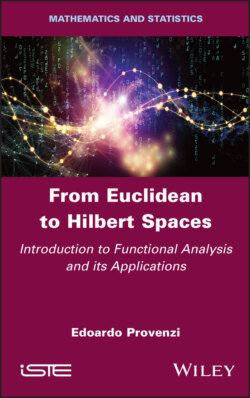Читать книгу From Euclidean to Hilbert Spaces - Edoardo Provenzi - Страница 2
Table of Contents
Оглавление1 Cover
2 Dedication
3 Title Page
4 Copyright
5 Preface
6 1 Inner Product Spaces (Pre-Hilbert) 1.1. Real and complex inner products 1.2. The norm associated with an inner product and normed vector spaces 1.3. Orthogonal and orthonormal families in inner product spaces 1.4. Generalized Pythagorean theorem 1.5. Orthogonality and linear independence 1.6. Orthogonal projection in inner product spaces 1.7. Existence of an orthonormal basis: the Gram-Schmidt process 1.8. Fundamental properties of orthonormal and orthogonal bases 1.9. Summary
7 2 The Discrete Fourier Transform and its Applications to Signal and Image Processing 2.1. The space ℓ2(ℤN) and its canonical basis 2.2. The orthonormal Fourier basis of ℓ2(ℤN) 2.3. The orthogonal Fourier basis of ℓ2(ℤN) 2.4. Fourier coefficients and the discrete Fourier transform 2.5. Matrix interpretation of the DFT and the IDFT 2.6. The Fourier transform in signal processing 2.7. Properties of the DFT 2.8. The DFT and stationary operators 2.9. The two-dimensional discrete Fourier transform (2D DFT) 2.10. Summary
8 3 Lebesgue’s Measure and Integration Theory 3.1. Riemann versus Lebesgue 3.2. σ-algebra, measurable space, measures and measured spaces 3.3. Measurable functions and almost-everywhere properties (a.e) 3.4. Integrable functions and Lebesgue integrals 3.5. Characterization of the Lebesgue measure on ℝ and sets with a null Lebesgue measure 3.6. Three theorems for limit operations in integration theory 3.7. Summary
9 4 Banach Spaces and Hilbert Spaces 4.1. Metric topology of inner product spaces 4.2. Continuity of fundamental operations in inner product spaces 4.3. Cauchy sequences and completeness: Banach and Hilbert 4.4. Remarkable examples of Banach and Hilbert spaces 4.5. Summary
10 5 The Geometric Structure of Hilbert Spaces 5.1. The orthogonal complement in a Hilbert space and its properties 5.2. Projection onto closed convex sets: theorem and consequences 5.3. Polar and bipolar subsets of a Hilbert space 5.4. The (orthogonal) projection theorem in a Hilbert space 5.5. Orthonormal systems and Hilbert bases 5.6. The Fourier Hilbert basis in L2 5.7. Summary
11 6 Bounded Linear Operators in Hilbert Spaces 6.1. Fundamental properties of bounded linear operators between normed vector spaces 6.2. The operator norm, convergence of operator sequences and Banach algebras 6.3. Invertibility of linear operators 6.4. The dual of a Hilbert space and the Riesz representation theorem 6.5. Bilinear forms, sesquilinear forms and associated quadratic forms 6.6. The adjoint operator: presentation and properties 6.7. Orthogonal projection operators in a Hilbert space 6.8. Isometric and unitary operators 6.9. The Fourier transform on S(ℝn), L1(ℝn) and L2(ℝn) 6.10. The Nyquist-Shannon sampling theorem 6.11. Application of the Fourier transform to solve ordinary and partial differential equations 6.12. Summary
12 Appendix 1: Quotient Space
13 Appendix 2: The Transpose (or Dual) of a Linear Operator
14 Appendix 3: Uniform, Strong and Weak Convergence
15 References
16 Index
17 End User License Agreement
